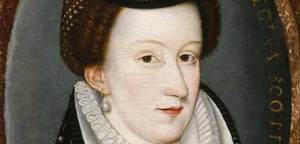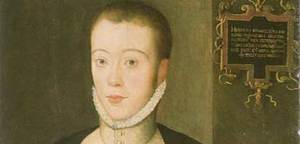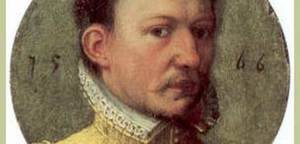An intriguing new medical analysis claims that Mary, the cousin of Elizabeth I, concocted a story of kidnap and alleged rape to justify her marriage to her third husband - potentially shedding light on a 400-year-old royal murder mystery.
Far from being the saintly and wronged Roman Catholic monarch portrayed in portraits and films, Mary was actually a "moral loose cannon", whose striking beauty and sex appeal gave Elizabeth other reasons to imprison and execute her, the researchers suggest.

|
| ©Unknown |
| Mary, Queen of Scots, was a captivating beauty and seen as a threat by Elizabeth 1. Mary was executed for treason after a 19 year stay in the Tower |
The study revolves around the report by Claude Nau, Mary's adviser and secretary, that on July 24, 1567, at Loch Levan Castle, Kinross, Mary miscarried twins. Information about the miscarriage is scant, but in May 1567, just 12 weeks after the murder of Mary's second husband, Lord Darnley, the Scottish Queen married James Hepburn, fourth Earl of Bothwell, who had abducted and "ravished" her at Dunbar Castle, in April, some sources say.
Mary later claimed that her pregnancy began after her marriage but experts now say this is impossible.
In a study published today in the Journal of Family Planning and Reproductive Healthcare, Lesley Smith, a medical historian, claims that it would have required modern microscopes and knowledge about foetal development to identify that the miscarriage was of twins after the seven weeks of pregnancy that Mary claimed.

|
| ©Unknown |
| Henry Stuart, Duke of Albany, Mary Queen of Scots first cousin, whom she married. A year later he was murdered |
It would also have been an "astonishing coincidence" if conception occurred at the time of the "rape", and even then the twins would have been just 12 weeks old and hard to identify upon miscarriage.
Instead, it is more likely that "the widowed Mary had an affair with Bothwell, became pregnant and had used the abduction story as a cover for her condition and justification for marriage," Ms Smith says.
Along with other historians, she believes both Mary and Bothwell to have been implicated in the death of Darnley, a drunken and controversial figure who was found strangled at Kirk O'Fields, Edinburgh, after being married to Mary for just 19 months.
Bothwell was a prime suspect but was acquitted at what is now regarded as a sham trial.
"Mary had an undoubted passion for Bothwell, her supposed kidnapper and did not try and escape from him despite ample opportunity. By contrast, she hated Darnley and was publicly separated from him by the time of his murder. The suspicion of an affair is not a new idea," Ms Smith says, "but the medical evidence brings us very much closer to the likely truth."

|
| ©Unknown |
| For marrying James Hepburn, Duke of Orkney, 4th Earl of Bothwell, Mary was condemned by Scottish Nobility |
Tony Roberts, a consultant obstetrician at Queen's Hospital, Burton on Trent, says that it would have required "a sensible and weathered eye" to identify a twin miscarriage at 12 weeks.
"If you want to prove pregnancy, a midwife in those days should have been able to do this, but standards were low, even for a queen," he adds.
As such, Claude Nau's report of the miscarriage implies that Mary became pregant by Bothwell well before the abduction. The unlikely possibility that Darnley was the father would have left the Queen at least five months pregnant with the twins, a condition which would have been "hardly unnoticeable", Ms Smith says.
The researcher, who is the curator of Tutbury Castle in Staffordshire, where Mary was held prisoner, says her theory further explains the animosity between Mary and Elizabeth I.
"Mary Stuart was a remarkable specimen of humanity," she writes. "She was 5ft 11in when the average woman was around 4ft 11in, so she was the equivalent of 6ft5in by modern standards. [She] was also beautiful and very sexually attractive. "All in all, Mary Queen of Scots was a very dangerous creature to the unmarried Protestant Elizabeth, and her physical presence made her positively intoxicating to anyone who met her."
She said: "All the available evidence creates a damning impression. Elizabeth probably considered Mary to be a moral loose cannon and fool for men. It is also interesting that, while Mary was prisoner in England there was no Catholic nation that made a serious attempt to release her: was there a more widely held view that she was better out of the way?"
Queen of plots
December 1542 Mary, above born to James V of Scotland. Her father dies when she is six days old and Mary becomes Queen of Scotland
1548 Henry VIII begins his "rough wooing" - a military campaign designed to impose marriage to his son on Mary. Instead she promises to marry the French Dauphin and flees to France
1559 Marries François II
1561 She returns to Scotland following François's death
1565 Marries Henry Stuart, Lord Darnley, her first cousin, below. Their son, James I of England, is born the following year
February 1567 Darnley found dead. James Hepburn, 4th Earl of Bothwell, bottom, is prime suspect
April 24 1567 Mary visits her son for the last time at Stirling but is abducted by Bothwell and taken to Dunbar Castle, where she is allegedly raped
May 15 1567 She marries Bothwell, a Protestant, to preserve her honour, but is condemned by the Scottish nobility
July 24 1567 Imprisoned at Loch Levan Castle by her own people, she miscarries twins and is forced to abdicate the Scottish throne
May 1568 Mary escapes but is defeated at Battle of Langside and flees to England, where she is captured and spends the next 19 years as a prisoner
1578 Bothwell dies, insane and imprisoned in Denmark
1587 Mary is found guilty of treason and executed



that's a wondrous opening of Great Psychopathic Bloodlines in History
diggin...